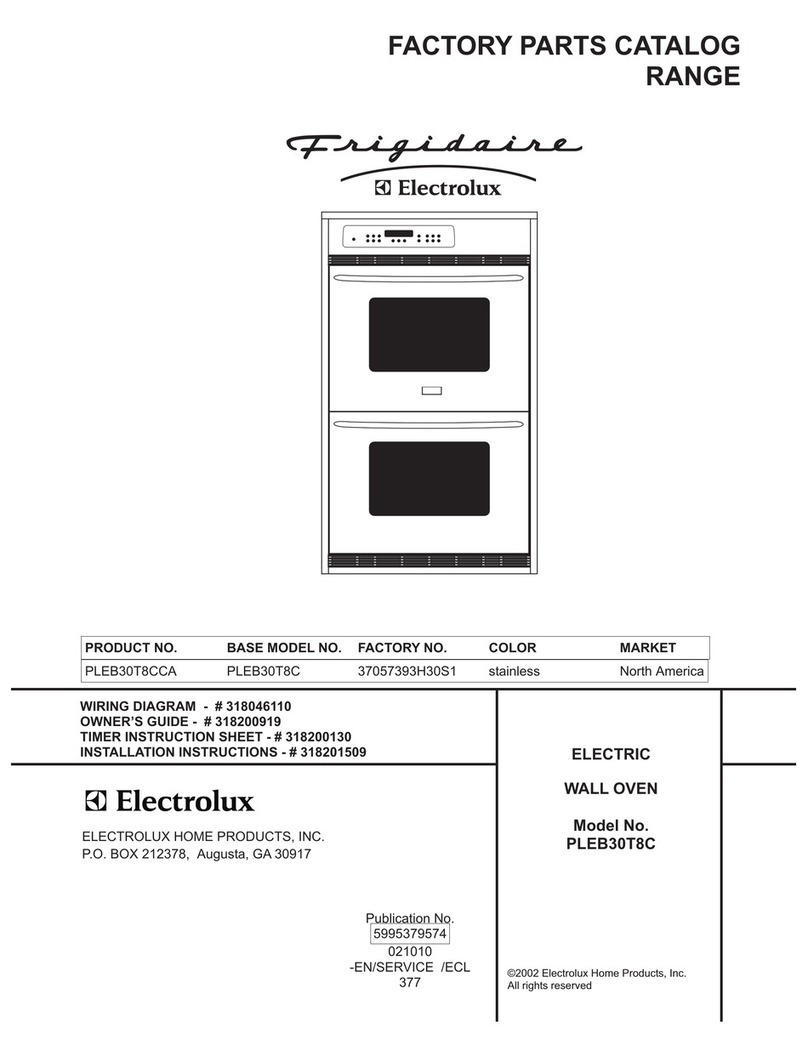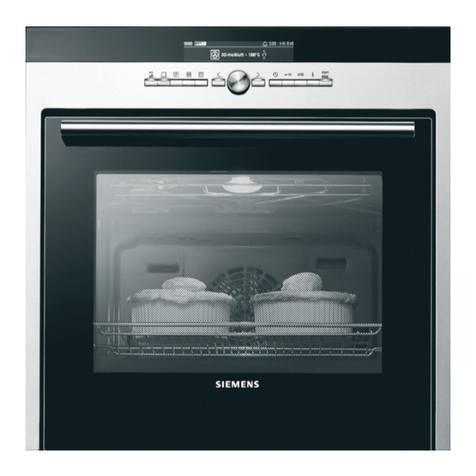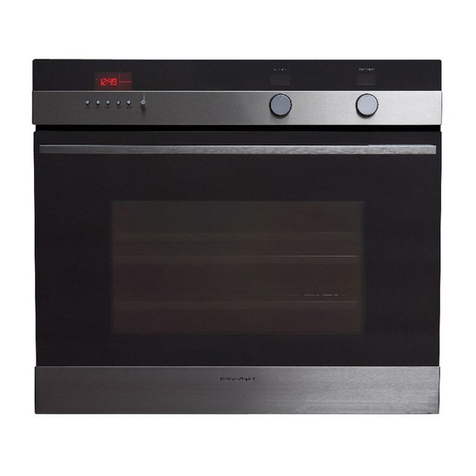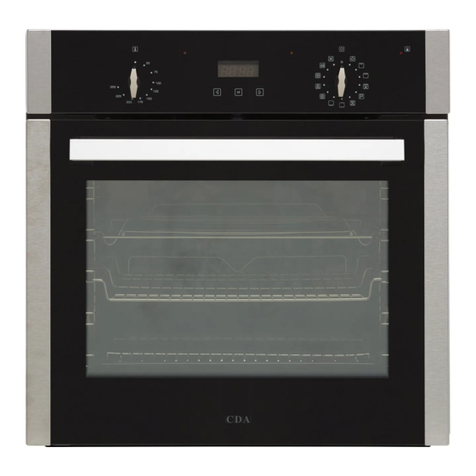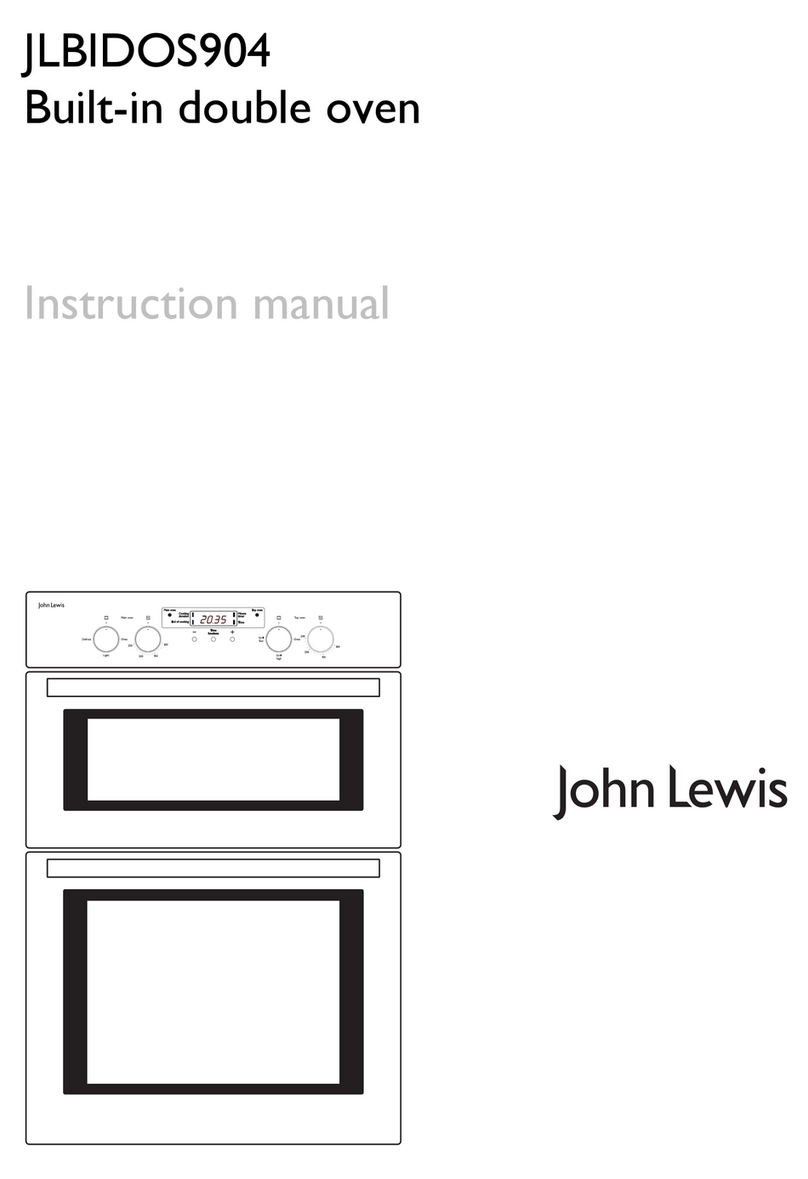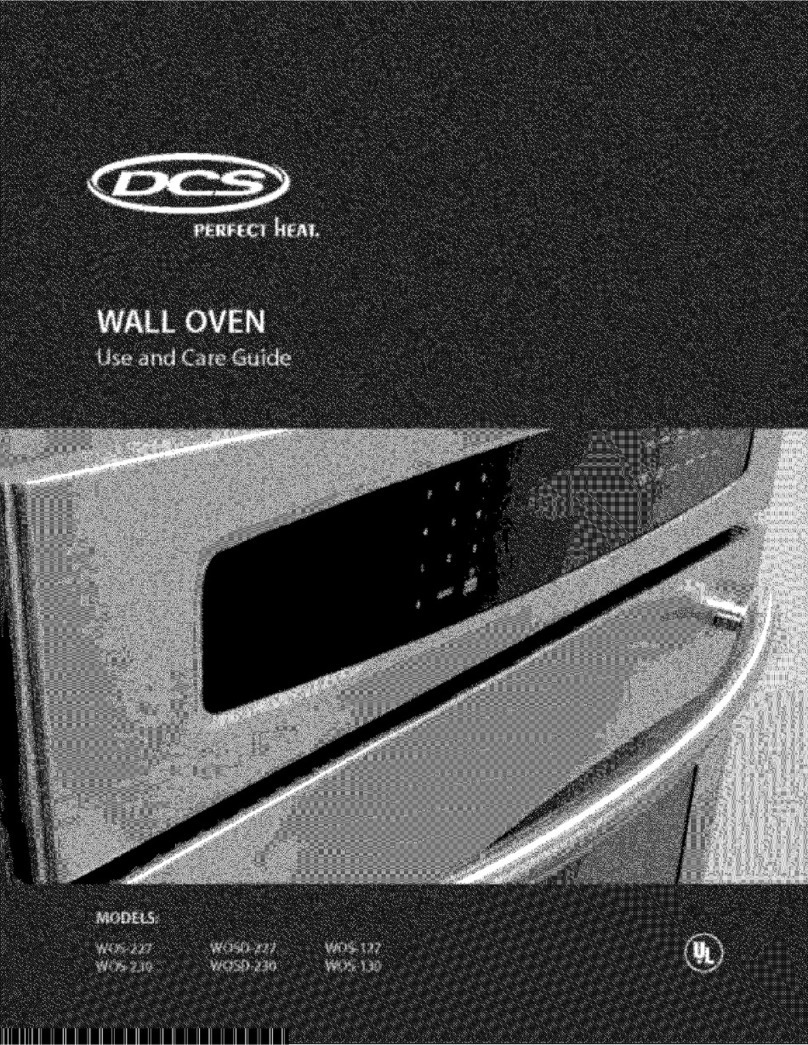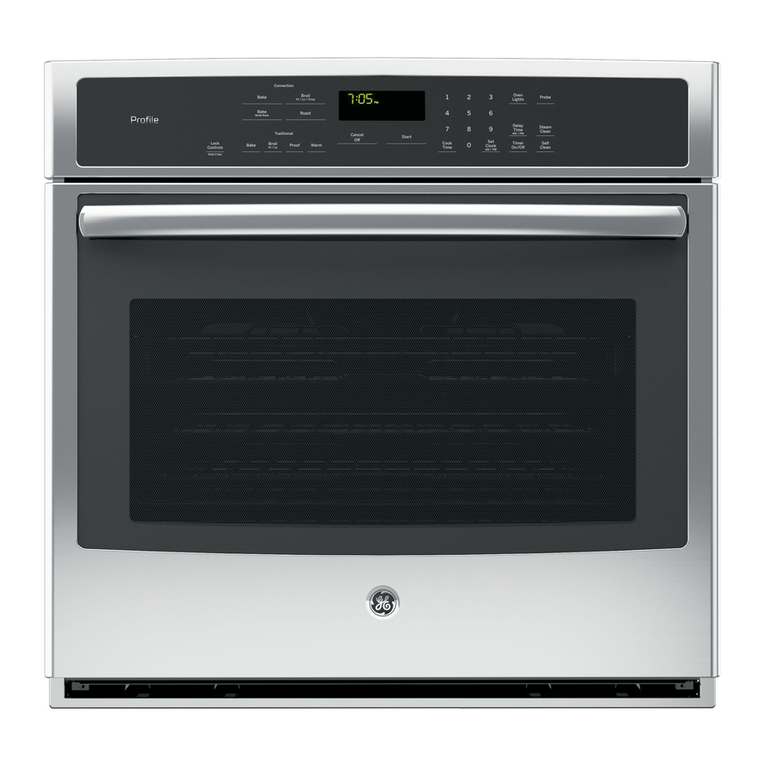Highland HIO75.2MP Technical specifications

Use and Installation Manual
for Single and Double Built-in Ovens
Pyrolitic – Full electronic
Before you begin, read these instructions completely and carefully.
IMPORTANT: Save these instructions for the local electrical inspector use.
INSTALLER: Please leave this manual with owner for future reference.
OWNER: Please keep this manual for future reference.
The contents are subject to change without notice
HIO75.2MP HIO75D.2MP

Use & Installation Manual
2
Table of Contents
IMPORTANT SAFETY INSTRUCTIONS ....................................................................................................4
Product Features .......................................................................................................................................5
About Your Oven ...........................................................................................................................5
Cooling Fan ...................................................................................................................................5
Rack Positions...............................................................................................................................5
Baking Elements............................................................................................................................6
Grilling Element .............................................................................................................................6
Convection Element.......................................................................................................................6
About Convection Ovens ...............................................................................................................6
The Control Panels....................................................................................................................................7
Command Keys .............................................................................................................................7
Display...........................................................................................................................................7
Knobs.............................................................................................................................................7
Oven Modes ...............................................................................................................................................8
Convection Bake and Defrost ........................................................................................................8
Fast Preheat ..................................................................................................................................8
Convection Grill .............................................................................................................................8
Bake...............................................................................................................................................8
Convection Roast ..........................................................................................................................8
Grill ................................................................................................................................................8
General Oven Information ........................................................................................................................9
General Oven Tips...................................................................................................................................10
Setting the Clock and Timer ...................................................................................................................12
Selecting the Oven Mode........................................................................................................................13
Time Oven Mode Operation....................................................................................................................14
Bake Tips and Techniques .....................................................................................................................15
Convection Bake Tips and Techniques.................................................................................................16
Defrost Tips and Techniques .................................................................................................................17
Convection Roast Tips and Techniques ...............................................................................................18
Convection Grill Tips and Techniques ..................................................................................................19
Grill Tips and Techniques.......................................................................................................................20
Special Features ......................................................................................................................................21
Sabbath Mode Instruction ......................................................................................................................21
Care & Cleaning.......................................................................................................................................22
Self-Cleaning Function ...........................................................................................................................23
Setting the Self-Clean Mode ...................................................................................................................24
Do-it-Yourself Maintenance Oven Door Removal.................................................................................25
Replacing an Oven Light ........................................................................................................................26
Solving Baking Problems .......................................................................................................................27
Solving Operational Problems ...............................................................................................................28
Assistance or Service ..................................................................................................................28
Installation Introduction..........................................................................................................................29
Tools You Will Need ....................................................................................................................29
Power Requirements ...................................................................................................................29
Oven Extendable Racks.............................................................................................................. 11

Use & Installation Manual
3
Choosing Oven Location............................................................................................................. 29
Steps For Installation .................................................................................................................. 29
Technical Data......................................................................................................................................... 30
Single Oven ................................................................................................................................ 30
Double Oven ............................................................................................................................... 30
Wall Installation, Single Oven................................................................................................................ 31
Wall Installation, Double Oven .............................................................................................................. 32
Electrical Supply..................................................................................................................................... 33
Wiring Requirements................................................................................................................... 33
Connecting The Oven To The Mains .......................................................................................... 33
Final Check List ...................................................................................................................................... 34
This appliance is in compliance with following European directives:
2006/95/CE (LVD), 2004/108/CE (EMC), 2002/95/CE (RoHS), 2002/96/CE
(WEEE), 2002/40/CE.

Use & Installation Manual
4
IMPORTANT SAFETY INSTRUCTIONS
WARNING - When using this appliance, basic safety precautions should always be followed to reduce
the risk of fire, electric shock, and/or injury to persons, including the following:
1. Read All Instructions before Using the Oven.
2. Proper Installation - Be sure your appliance is properly installed and grounded by a qualified
technician. Have the installer show you where the fuse or breaker box is located and how to turn off
the power to the oven.
3. Do Not Operate the Oven if it is Damaged or not working Properly including broken glass:
electric shock may occur. Disconnect it from the Mains and Call Service.
4. Never Use Your Appliance for Warming or Heating the Room.
5. Do Not Leave Children Alone - Children should not be left alone or unattended in area where the
appliance is in use. They should never be allowed to sit or stand on any part of the appliance.
Children should be supervised to ensure that they do not play with the appliance.
6. Do Not Touch Heating Elements or Interior Surfaces of Oven - Heating elements may be hot
even though they are dark in color. Interior surfaces of the oven, including racks become hot enough
to cause serious burns. Accessible parts may become hot during use. Young children should be kept
away. Do not touch or let clothing or other flammable material come into contact with the heating
elements or interior surfaces or racks of the oven during or immediately after use. During the oven
operation, the front is heated as well; consequently keep children clear of the oven, specially during
self-cleaning. Allow the oven to cool.
7. Wear Proper Apparel - Loose-fitting or hanging garments should never be worn while using the
appliance. Fabric may ignite and result in personal injury.
8. Use Only Dry Oven Gloves - Moist or damp oven gloves on hot surfaces may result in burns from
steam. Do not let oven gloves touch hot heating elements. Do not use a towel or other bulky cloth.
9. User Servicing - Do not repair or replace any part of the appliance unless specifically recommended
in the manual. All other service should be referred to a qualified technician.
10. Storage in or on the Appliance - Flammable materials should not be stored in an oven or near
surface units.
11. Do Not Use Water on Grease Fires - Smother fire or flame or use dry chemical or foam type
extinguisher.
12. Use Care when Opening Door - Let hot air or steam escape before removing or replacing food.
13. Do Not Heat Unopened Food Containers - Build-up of pressure may cause the container to burst
and result in injury.
14. Keep Oven Vent Ducts Unobstructed.
15. Placement of Oven Racks - Always place oven racks in desired location while oven is cool. If rack must
be moved while oven is hot, do not let the oven glove contact the hot heating element in the oven.
16. It is recommended that not abrasive detergents and no steam cleaning equipment are used.
17. Do Not Clean the Door Gasket - The door gasket is essential for a good seal. Care should be taken
not to rub, damage, or move gasket.
18. Do Not Use Oven Cleaners - No commercial oven cleaner or oven liner protective coating of any
kind should be used in or around any part of the oven.
19. Clean Only Parts Listed in Manual.
20. Before Self-Cleaning the Oven - Remove oven racks and other utensils.
21. Check Knobs are in Off Position When Finished Cooking - Always check the position of the oven
control knobs when you have finished cooking to make sure they are all in the off positions.
22. “CAUTION” - Do not store items of interest to children in cabinets above the oven – children
climbing on the oven to reach items could be burned or seriously injured.
23. Always Disconnect the Electrical Supply before Servicing the Oven.
24. Warning! The appliance is not intended for use by young children or infirm persons without
supervision.

Use & Installation Manual
5
Product Features
Figure 1
About Your Oven
Above you will find an illustration of a oven
showing the components of the oven.
Cooling Fan
The oven has a cooling fan to cool the control
panel.
You may hear this fan continue to run after
cooking and/or cleaning has been completed.
The fan will run as long as the oven is hot and the
oven’s function selector is turned to any position
other than “Off”.
This is normal operation.
Rack Positions
The oven has rack guides at four levels as shown
in the illustration.
Each level guide consists of paired supports
formed in the sidewalls on each side of the oven
cavity.
The rack should be positioned within the paired
supports.
Always be sure to position the oven racks, etc.
before turning the oven on.
Make sure that the rack(s) are level once they are
in position.
Figure 2

Use & Installation Manual
6
Baking Elements
The oven uses two elements for baking: one
located at the top of the oven and the second
located below the floor of the oven cavity to
provide ease in cleaning the oven cavity.
Grilling Element
The grilling element of the oven is located at the
top of the oven cavity.
Do not touch the heating element or let oven
gloves touch the grilling element.
Never use a towel or bulky cloth for an oven
glove; they could catch on fire.
Convection Element
The convection element (not visible) and fan are
located at the back of the oven cavity.
This element and fan combination performs the
cooking when in the convection bake mode.
When in any of the convection modes the fan is
on, see Table 1.
About Convection Ovens
Although most people are familiar with the
operation of a conventional oven many are
unclear as to how a convection oven works or in
what ways it is superior to a conventional oven.
Below you will find a brief explanation of how a
convection oven works and its advantages. In
Ovens, the European Convection system (the 3
elements, fan and venting panel) circulates even,
heated air throughout the oven.
This process:
• Seals in juices and flavour
•Provides even baking and browning
• Saves time and energy
• Baking on multiple levels at the same time
• Bakes whole meals at once with no flavour
transfer
•Defrosts evenly
Many of your own recipes have time and
temperature instruction for the regular bake cycle.
As a rule, most of these recipes can be cooked
with better results in one of the convection cycles.
In general, to convert standard recipes for use in
convection, you reduce the temperature by about
10 °C and check if cooked at the minimum
suggested cooking time.
When baking on more than 1 rack it may be
necessary to increase the cooking time a few
minutes for each additional rack. As individual
tastes vary, you may find you need to adjust the
time and temperature to achieve desired results.
You may feel your new oven cooks differently
than your old oven. We recommend you use the
various cooking cycles for a few months to
become more familiar with it.
We do not recommend you use oven
thermometers found at many grocery stores to
check oven temperature. They may be inaccurate
and are slow to respond to temperature changes.

Use & Installation Manual
7
The Control Panels
The user interface has the following features:
display, preheat light indicators, keys for
commands, cooking mode and temperature
selectors.
DOUBLE OVEN SINGLE OVEN
Figure 3
Command Keys
[CLOCK ]: press it to set or change the time of day.
[TIMER]: press it to set or clear the minute
minder.
[COOK]: press this key to set or change the
duration of a cooking activity.
[STOP]: press to set or change the stop time
in a timed or delayed cooking.
Whenever one of the former keys has been
pressed and the time digits are blinking, press
and/or hold the following keys to change the
values.
[LIGHT]: press it to switch the oven lights status.
The function of this key depends on the oven
model:
[UPPER / LOWER] (double oven): press it to
select the upper cavity if none is selected.
If one of the two is already selected, simply
toggle to the other one.
[LOCK] (single oven): hold it together with [+] to
operate safety lock.
[INCREMENT] [+]: press to increase the value of
the currently selected variable.
[DECREMENT] [-]: press to decrease the value
of the currently selected variable.
Display
Preheat light (external).
Four time digits (blu), for time of day, minute
minder, automatic cooking. AM/PM indication is
also present.
Three temperature digits (red), for oven
temperature. Degree unit (°C or °F) indication is
present. It shows the temperature set-point for
the current cooking mode, in the selected cavity.
Box and lock icons to show which cavity is
currently selected and which door, if any, is fully
locked, while running in clean or cooling down
after a clean.
Writings to indicate which function is active
(steady) or waiting for a user input (blink).
Knobs
Cooking mode selector
Cooking modes + OFF position.
Temperature selector.
PRESET and CLEAN positions + continuous
range between MIN and MAX values.
Multifunction knobs
Figure 4

Use & Installation Manual
8
Oven Modes
The following illustrations give an overview of
what happens in the oven with each mode
setting.
The arrows represent the location of the heat
source during specific modes. The lower element
is concealed under the oven floor.
Table 1. Cooking function settings
Convection Bake and Defrost
Convection Bake cooks with heat from a third
element behind the back wall of the oven. The
heat is circulated throughout the oven by the
convection fan.
Defrost – Use for defrosting. No elements
operate, only the fan is ON.
Fast Preheat
Fast Preheat uses the ring element and the
additional element to heat rapidly the cavity.
When the preheat tone is sounded and the red
light turns off, select the desired cooking mode.
Convection Grill
Convection Grill combines the intense heat from
the upper element with the heat circulated by the
convection fan.
Bake
Is cooking with heated air. Both the upper and
lower element cycle to maintain the oven
temperature.
Convection Roast
Convection Roast uses the top element, bottom
element and convection fan.
Grill
Grilling uses intense heat radiated from the upper
element.

Use & Installation Manual
9
General Oven Information
Before using your oven for the first time remove
all packing and external materials from the
oven(s).
Any material of this sort left in the oven(s) may
melt and/ or burn when the oven(s) is(are) used.
Flashing Symbols or Numbers
Signals an incomplete setting and calls for
another input.
Beeps
Signals that more information must be entered or
confirms the receipt of an entry.
Beeps also signal the end of a function or an
oven fault.
Fast Preheat
Whenever the oven must heat rapidly, turn the
cooking mode selector to fast preheat position.
As soon as the preheat tone is sounded and the
red light turns off, select the desired cooking
mode and put food inside.
Lock Symbol
It’s displayed when the door is locked, during the
Self-Clean mode or following cooling down.
The symbol flashes when the latch is moving to
lock or unlock the door. Do not attempt to open
the door. Door can be opened when the symbol
no longer appears.
Safety door lock
The door latch mechanism is not used only to
lock the door in self-clean but also to lock the
door manually for safety reasons (to prevent
children from touching hot parts) during ordinary
cooking activities.
Single oven: hold both the INC (+) and LOCK
keys for 3 seconds.
The latch will lock the door. Repeat the same
operation to unlock.
Double oven: hold both the INC (+) and DEC (-)
keys for 3 seconds.
The latch will lock the door. Repeat the same
operation to unlock.
Power Failure
After the power returns to the oven, the clock
displays the time 12.00AM.
Default Settings
The cooking modes automatically select a
suitable temperature when the selector is in the
preset position. These can be changed when a
different one is needed.
F Failure Number Codes
These codes are displayed when the electronic
control detects a problem in the oven or in the
electronics.
Convection Fan
The convection fan operates during any
convection mode. When the oven is operating in
the convection mode, the fan will turn off
automatically when the door is opened (only for
75 cm). The convection fan will run during the
preheat time too.
Component Cooling Fan
Activates during any cooking or self-cleaning
mode to cool inner components and outer door
surfaces. This air is exhausted through the vent
located above the oven door. It continues to run
until components have cooled sufficiently. The
cooling fan speed is high in self-clean and
whenever the internal components temperature
becomes high.

Use & Installation Manual
10
General Oven Tips
Preheating the Oven
x Preheat the oven when using the Bake,
Convection Bake and Convection Roast
modes.
x Use fast preheat mode when a short time is
requested to preheat the oven.
x Selecting a higher temperature does not
shorten the preheat time.·
x Preheating is necessary for good results
when baking cakes, cookies, pastry and
breads.·
x Preheating will help to sear roasts and seal in
meat juices.·
x Place oven racks in their proper position
before preheating.·
x During preheat, the selected cooking
temperature is always displayed.
x A beep will confirm that the oven is preheated
and the preheat light will turn off.
x Fast Preheat can be used when time is
crucial.
Operational Suggestions
x Use the cooking charts as a guide.
x Do not set pans on the open oven door.·
x Use the interior oven light to view the food
through the oven door window rather than
opening the door frequently.
Utensils
x Glass baking dishes absorb heat. Reduce
oven temperature 15 °C (25 °F) when baking
in glass.
x Use pans that give the desired browning. The
type of finish on the pan will help determine
the amount of browning that will occur.
x Shiny, smooth metal or light non-stick /
anodized pans reflect heat, resulting in lighter,
more delicate browning. Cakes and cookies
require this type of utensil.
x Dark, rough or dull pans will absorb heat
resulting in a browner, crisper crust. Use this
type for pies.
x For brown, crisp crusts, use dark non-stick /
anodized or dark, dull metal utensils or glass
bake ware. Insulated baking pans may
increase the length of cooking time.
x Do not cook with the empty broiler pan in the
oven, as this could change cooking
performance. Store the broil pan outside of
the oven.
Oven Condensation and Temperature·
x It is normal for a certain amount of moisture to
evaporate from the food during any cooking
process. The amount depends on the moisture
content of the food. The moisture may
condense on any surface cooler than the inside
of the oven, such as the control panel.
x Your new oven has an electronic temperature
sensor that accurately maintains the
temperature selected. Your previous oven may
have had a mechanical thermostat that drifted
gradually over time to a higher temperature. It is
normal that you may need to adjust your
favourite recipes when cooking in a new oven.
High Altitude Baking
x When cooking at high altitude, recipes and
cooking time will vary from the standard.
Oven Racks
x The oven has rack guides at four levels as
shown in the illustration on Page 5.·
x Rack positions are numbered from the bottom
rack guide (#1) to the top (#4).·
x Check cooking charts for best rack positions
to use when cooking.
x Each level guide consists of paired supports
formed in the walls on each side of the oven
cavity.
x Always be sure to position the oven racks
before turning on the oven. Make sure that
the racks are level once they are in position.
Please refer to illustration on Page 5 if there is
any question as to which side is the front of the
rack.
x The racks are designed to stop when pulled
forward to their limit.
CAUTION
Never use aluminum foil to cover the oven
racks or to line the oven. It can cause damage
to the oven liner if heat is trapped under the
foil.
Make sure you do not force it to avoid
damage to the enamel.

Use & Installation Manual
11
To remove oven rack from the oven:
1. Pull rack forward
2. Lift rack up at front and then remove it
To replace an oven rack:
1. Place rear of rack between rack level
guides
2. While lifting front of rack, slide rack in all
the way while lowering the front
Oven Extendable Racks
x The extendable rack allows for easier access
to cooking foods. It extends beyond the
standard flat rack bringing he food closer to
the user.
CAUTION
When the rack is outside of the oven, slide
arms do not lock. They could unexpectedly
extend if the rack is carried incorrectly.
Extending slide arms could cause injury.
Rack should only be held or carried by
grasping the sides.
NOTE: Always remove the extendable rack
before self-cleaning the oven.
CAUTION
To avoid burns, pull rack all the way out and
lift pan above handle when transferring food
to and from oven.
Please refer to illustration on Page 5 if there is
any question as to which side is the front of the
rack.
To remove extendable rack from the oven:
1. Lift of rack slightly and push it until the
stop release
2. Raise back of rack until frame and stop
clear rack guide
3. Pull rack down and out
To replace an extendable rack:
1. Grasp rack firmly on both sides. Place
rack (including frame) above desired rack
guide
2. Push all the way in until the back of the
rack drops into place
3. Pull both sections forward until stops
activates. Rack should be straight and
flat, not crooked

Use & Installation Manual
12
Setting the Clock and Timer
The time of day is displayed in hours and
minutes.
Always set the clock immediately after installation
or after a power failure. Once power returns to
the oven, the clock displays the time 12:00AM or
0:00 depending on the clock format.
The clock time will appear during all oven
operations except when the timer or a timed
cooking operation is running.
The oven is preset to a 12-hour clock and
indicates AM and PM.
To Set the Clock
1. Press [CLOCK]. The hours will begin
flashing and the display will show the CLOCK
writing.
2. Press [+] or [-] to set the desired hour.
Continue until correct AM or PM is selected.
3. Press [CLOCK] again to confirm the hour
and minutes will start flashing.
4. Press [+] or [-] to set the desired minutes
value, hold the key to change by 10 minute
steps.
5. Press [CLOCK] again to confirm the time
or wait for 5 seconds.
The following appears when edit mode is active
to set or change the value.
To Set the Timer
1. Press [TIMER]. The timer and TIMER writing
will appear on the display.
2. Press [TIMER] again. The hours value will
start flashing.
3. Press [+] or [-] to set the desired hour.
4. Press [TIMER] again to confirm the hour and
minutes will start flashing.
5. Press [+] or [-] to set the desired minutes
value, hold the key to change by 10 minute
steps.
6. Press [TIMER] again to confirm the value or
wait for 5 seconds.
7. TIMER will be steadily displayed.
8. When the time ends, reminder beeps will
sound for 15 minutes or until the key is
pressed.
9. Timer format is usually HR:MIN but it
switches to MIN:SEC during the last minute.
10. The displayed value is always rounded to the
lower minute.

Use & Installation Manual
13
Selecting the Oven Mode
To Set a Cooking Mode and Temperature
x The following modes can be selected by
moving the cooking mode knob to the desired
position. To select Clean, the temperature
knob must also be moved into the appropriate
Clean position.
MULTIFUNCTION
CAVITY
THERMAL CAVITY
OFF OFF
CONVECTION BAKE BAKE / ECO BAKE
CONVECTION GRILL GRILL
COVECTION ROAST CLEAN
FAST PREHEAT
BAKE / ECO BAKE
GRILL
DEFROST
CLEAN
x Select the desired temperature moving the
selector or leave it in the PRESET position if
the proposed value is fine.
The temperature can be changed by 5 °C
or 5 °F steps.·
x As soon as one of the knobs is moved, the
control switches automatically to display the
value in the correspondent cavity.
The corresponding box will be displayed.
x Cavity will begin to heat and oven light will
turn on.
x Preheat light will turn on. When the oven has
preheated, it will beep and switch the red light
off.·
x To change the temperature while cooking,
simply turn the temperature knob until the
display shows the desired value.
x Press [UPPER/LOWER] to select the desired
cavity and check the related temperature or
time values, even is there’s no need to
change those.·
x Move the cooking mode selector to OFF if
you intend to stop cooking.
Eco Bake
The Eco Bake function is a special mode that
assures a low energy consumption. It’s working
using the same heating elements of the Bake
function with a special consideration to power
saving.
To enable this mode, operate as follows:
1. Move the temperature selector to the Eco
Bake position.
2. Move the mode selector to the Eco Bake
position, all the others are disabled.
3. As soon as the cooking activity starts, move
the temperature selector in order to set the
desired temperature. The oven lights don’t
turn on automatically, use the [LIGHT] button
if you need to check the food inside.
Using Oven Lights
x A single light key activates the lights in either
oven.·
x If LIGHT key is touched when both ovens are
off, lights in both the upper and lower oven
will turn on.
Touch LIGHT key again, and both oven lights
will turn off.
x Oven lights turn on and off automatically
when the door is opened and closed (only for
75 cm).·
x When an oven is in use, oven lights turn on
automatically when a mode is started.
Oven lights will turn off automatically when
the oven mode is cancelled.
x The lights do not operate in the Self-Clean
mode.
To manually control the interior oven lights in
either the upper or lower oven if one or both
ovens are in use:
1. Press UPPER/LOWER, the display will
indicate which oven is selected.
2. Press UPPER/LOWER to highlight the other
oven.
3. Press LIGHT to turn lights on or off.

Use & Installation Manual
14
Time Oven Mode Operation
x In double oven models, both ovens can be
set independently to operate a timed mode.
x Be sure that the time-of-day clock is
displaying the correct time.
x The timed mode turns off the oven at the end
of the cook time.
To Set Timed Mode
1. Select the cooking mode and the temperature
by means of the knobs.
2. Select oven by means of [UPPER/LOWER]
key, if necessary.
3. If necessary, change the default temperature
at this time by turning the knob.
4. Press [COOK] key. The COOK and the
TIME writings will appear in the display
beside the cook time and the hour digits will
begin flashing.
5. Press [+] or [-] to change the hours. Keep in
mind that the time required for the oven to
reach the temperature must be included in
the set cooking time.
6. Press [COOK ] again, the hours will be
confirmed and the minutes digits will begin
flashing.
7. Press [+] or [-] to change the minutes. Hold
the key to change by 10 minutes steps.
8. Press [COOK] once again or wait for a
few seconds to confirm the whole cook time
value.
9. At the end of the programmed cooking time,
the oven will automatically turn off.
To Delay the Start of a Timed Mode
Follow steps 1 through 9 above.
x Press [STOP] key. DELAY will appear
in the display, beside the stop time and the
hour digits will begin flashing.
x Press [+] or [-] to change the hours.
x Press [STOP] again, the hours will be
confirmed and the minutes digits will begin
flashing.
x Press [+] or [-] to change the minutes. Hold
the key to change by 10 minutes steps.
x Press [STOP] once again or wait for a
few seconds to confirm the whole stop time
value.
x The clock automatically calculates the time of
day at which the mode starts and stops.
The displayed cooking time counts down by
the minute.
The oven turns on and heats to the set
temperature, for the selected number of hours
and minutes.
x At the end of the programmed cooking time,
the oven will automatically turn off.
Display will show End and the oven will beep.
Reminder beeps will sound for up to fifteen
minutes until any key is touched.
x Whenever it’s necessary to check a time
value that is not displayed, press the
corresponding key to view the desired value
for 5 seconds.
x Example: if the timer value is displayed, press
cook time key to view the cook time for 5
seconds.
x Timer value is displayed when both timer and
cook time are running.

Use & Installation Manual
15
Bake Tips and Techniques
Baking is cooking with heated air. Both upper and
lower elements in the oven are used to heat the
air but no fan is used to circulate the heat.
Follow the recipe or convenience food directions
for baking temperature, time and rack position.
Baking time will vary with the temperature of
ingredients and the size, shape and finish of the
baking utensil.
General Guidelines
x For best results, bake food on a single rack
with at least 1" - 1 ½” (2.5 – 3 cm) space
between utensils and oven walls.
x Use one rack when selecting the bake mode.
x Check for doneness at the minimum time.·
x Use metal bake ware (with or without a non
stick finish), heatproof glass, glass-ceramic,
pottery or other utensils suitable for the oven.
x When using heatproof glass, reduce
temperature by 15 °C (25 °F) from
recommended temperature.
x Use baking sheets with or without sides or
jelly roll pans.
x Dark metal pans or nonstick coatings will
cook faster with more browning.
Insulated bake ware will slightly lengthen the
cooking time for most foods.
x For best results, bake food on a single rack
with at least 1" - 1 ½” (2.5 – 3 cm) space
between utensils and oven walls.
x Do not use aluminum foil or disposable
aluminum trays to line any part of the oven.
Foil is an excellent heat insulator and heat will
be trapped beneath it.
This will alter the cooking performance and
can damage the finish of the oven.
x Avoid using the opened door as a shelf to
place pans.·
x Tips for Solving Baking Problems is found on
Page 28.
Bake Chart
FOOD ITEM RACK POSITION TEMPERATURE °C (°F)
(PREHEATED OVEN) TIME (MIN)
Cake
Cupcakes 2 175 (350) 17-19
Bundt Cake 1 175 (350) 37-43
Angel Food 1 175 (350) 35-39
Pie
2 crust, fresh, 9" 2 190-220 (375-425) 45-55
2 crust, frozen fruit, 9" 2 190 (375) 68-78
Cookies
Sugar 2 175-190 (350-375) 6-11
Chocolate Chip 2 175-190 (350-375) 8-13
Brownies 2 175 (350) 29-36
Breads
Yeast bread loaf, 9x5 2 190 (375) 18-22
Yeast rolls 2 190-205 (375-400) 12-15
Biscuits 2 190-205 (375-400) 11-15
Muffins 2 220 (425) 15-19
Pizza
Frozen 2 205-235 (400-450) 23-26
Fresh 2 220-235 (425-450) 12-15

Use & Installation Manual
16
Convection Bake Tips and Techniques
Reduce recipe baking temperatures by 15 °C
(25 °F).·
x For best results, foods should be cooked
uncovered, in low-sided pans to take
advantage of the forced air circulation.
Use shiny aluminum pans for best results
unless otherwise specified.
x Heatproof glass or ceramic can be used.
Reduce temperature by another 15 °C (25 °F)
when using heatproof glass dishes for a total
reduction of 30 °C (50 °F).
x Dark metal pans may be used.
Note that food may brown faster when using
dark metal bake ware.
x The number of racks used is determined by
the height of the food to be cooked.
x Baked items, for the most part, cook
extremely well in convection.
Don’t try to convert recipes such as custards,
quiches, pumpkin pie, or cheesecakes, which
do not benefit from the convection-heating
process.
Use the regular Bake mode for these foods.
x Multiple rack cooking for oven meals is done
on rack positions 1, 2 and 3.
All four racks can be used for cookies,
biscuits and appetizers.
–2 Rack baking: Use positions 1 and 3.
–3 rack baking: Use positions 2, 3 and 4.
–When baking four cake layers at the same
time, stagger pans so that one pan is not
directly above another. For best results,
place cake son front of upper rack and
back of lower rack (See graphic at right).
Allow 1" - 1 ½” (2.5 – 3 cm) air space
around pans.
x Converting your own recipe can be easy.
Choose a recipe that will work well in
convection.
x Reduce the temperature and cooking time if
necessary. It may take some trial and error to
achieve a perfect result. Keep track of your
technique for the next time you want to
prepare the recipe using convection.
x Tips for Solving Baking Problems are found
on Page 28.
Foods recommended for Convection Bake
mode:
Appetizers Biscuits Coffee Cakes
Cookies (2 to 4 racks) Yeast Breads
Cream Puffs
Popovers
Casseroles and One-Dish Entreés
Oven Meals (rack positions 1, 2, 3)
Air Leavened Foods (Soufflés, Meringue,
Meringue-Topped Desserts, Angel Food
Cakes, Chiffon Cakes)
Figure 5
Quick and easy recipe tips:
Converting from standard
BAKE to CONVECTION BAKE:
x Reduce the temperature by 15 °C (25 °F).
x Use the same baking time as Bake mode if
under 10 to 15 minutes.
x Foods with a baking time of less than 30
minutes should be checked for doneness 5
minutes earlier than in standard bake
recipes.
x If food is baked for more than 40 to 45
minutes, bake time should be reduced by
25%.

Use & Installation Manual
17
Convection Bake Chart
Reduce standard recipe temperature by 15 ºC
(25 °F) for Convection Bake.
Temperatures have been reduced in this chart.
This chart is a guide.
Follow recipe or package directions and reduce
temperatures appropriately.
FOOD ITEM RACK POSITION TEMPERATURE °C (°F)
(PREHEATED OVEN) TIME (MIN)
Cake
Cupcakes 2 160 (325) 17-19
Bundt Cake 1 160 (325) 37-43
Angel Food 1 160 (325) 35-39
Pie
2 crust, fresh, 9" 2 175-205 (350-400) 45-55
2 crust, frozen fruit, 9" 2 175 (350) 68-78
Cookies
Sugar 2 160-175 (325-350) 6-11
Chocolate Chip 2 160-175 (325-350) 8-13
Brownies 2 160 (325) 29-36
Breads
Yeast bread loaf, 9x5 2 175 (350) 18-22
Yeast rolls 2 175-190 (350-375) 12-15
Biscuits 2 175-190 (350-375) 11-15
Muffins 2 205 (400) 15-19
Pizza
Frozen 2 190-220 (375-425) 23-26
Fresh 2 205-220 (400-425) 12-15
Defrost Tips and Techniques
–Use for defrosting of small pieces (bread, meat, fish fillet)
–No elements operate, only the fan is ON.
–Use only on second level.

Use & Installation Manual
18
Convection Roast Tips and Techniques
x Preheat for Convection Roast.
x Roast in a low-sided, uncovered pan.
x When roasting whole chickens or turkey, tuck
wings behind back and loosely tie legs with
kitchen string.
x Use the 2-piece broil pan for roasting
uncovered.
x When roasting a large roast or turkey,
roasting pan may need to be rotated during
roasting time. This will allow for more even
cooking. Large birds may also need to be
covered with foil (and pan roasted) during a
portion of the roasting time to prevent over-
browning.
Quick and easy recipe tips:
Converting from standard
BAKE to CONVECTION ROAST:
x Temperature does not have to be lowered.
x Roasts, large cuts of meat and poultry
generally take 10-20% less cooking time.
Check doneness early.
x Casseroles or pot roasts that are baked
covered in CONVECTION ROAST will cook
in about the same amount of time.
x The minimum safe temperature for stuffing in
poultry is 75 °C (165 ºF).
x After removing the item from the oven, cover
loosely with foil for 10 to 15 minutes before
carving.
x While covered, roast temperatures increase
by 3° to 6 °C (5° to 10 °F).
Convection Roast Chart
MEATS WEIGHT
(lb)
OVEN TEMP.
°C (°F)
RACK
POSITION
TIME
(min. per lb)
INTERNAL TEMP.
°C (°F)
Beef
Rib Roast 4-6 160 (325) 2 24-30 63 (145) medium rare
27-33 71 (160) medium
Rib Eye Roast, (boneless) 4-6 160 (325) 2 22-30 63 (145) medium rare
27-33 71 (160) medium
Rump, Eye, Tip, Sirloin (boneless) 3-6 160 (325) 2 22-28 63 (145) medium rare
27-33 71 (160) medium
Tenderloin Roast 2-3 220 (425) 2 15-25 63 (145) medium rare
Pork
Loin Roast (boneless or bone-in) 5-8 175 (350) 2 20-30 71 (160) medium
Shoulder 3-6 175 (350) 2 25-35 71 (160) medium
Poultry
Chicken whole 3-4 190 (375) 2 18-21 82 (180)
Turkey, not stuffed 12-15 160 (325) 1 10-14 82 (180)
Turkey, not stuffed 16-20 160 (325) 1 9-11 82 (180)
Turkey, not stuffed 21-25 160 (325) 1 6-10 82 (180)
Turkey Breast 3-8 160 (325) 1 15-20 77 (170)
Comish Hen 1-1 ½ 175 (350) 2 45-75 total 82 (180)
Lamb
Half Leg 3-4 160 (325) 2 25-30 71 (160) medium
30-35 77 (170) well
Whole Leg 6-8 160 (325) 1 25-30 71 (160) medium
30-35 77 (170) well

Use & Installation Manual
19
Convection Grill Tips and Techniques
x Place rack in the required position needed
before turning on the oven.·
x Use Convection Grill mode with the oven door
closed.·
x Do not preheat oven.
x Use the 2-piece broil pan.·
x Turn meats once halfway through the cooking
time (see convection grill chart).
Convection Grill Chart
FOOD AND THICKNESS RACK
POSITION
BROIL SETTING
°C (°F)
INTERNAL
TEMP. °C (°F)
TIME
SIDE 1 (MIN.)*
TIME
SIDE 2 (MIN.)*
Beef
Steak (1-½" or more)
Medium rare 2 235 (450) 65 (145) 12-14 11-13
Medium 2 235 (450) 71 (160) 15-17 13-15
Well 2 235 (450) 77 (170) 18-20 16-17
Hamburgers (more than 1")
Medium 3 290 (550) 71 (160) 9-11 5-8
Well 3 290 (550) 77 (170) 11-13 8-10
Poultry
Chicken Quarters 3 235 (450) 82 (180) 16-18 14-16
(thigh)
Chicken Breasts 3 235 (450) 77 (170) 14-16 12-14
Pork
Pork Chops (1¼" or more) 2 235 (450) 71 (160) 12-14 13-15
Sausage - fresh 3 235 (450) 71 (160) 4-6 3-5
*Grill and convection grill times are approximate and may vary slightly.

Use & Installation Manual
20
Grill Tips and Techniques
x Place rack in the required position needed
before turning on the oven.·
x Use Grill mode with the oven door closed.
x Do not preheat oven.
x Use the 2-piece broil pan.
x Meats may be brushed with cooking oil or
butter to prevent sticking.
x Turn meats once halfway through the cooking
time (see grill chart).
Grill Chart
FOOD AND THICKNESS RACK
POSITION
BROIL
SETTING
INTERNAL
TEMP. °C (°F)
TIME
SIDE 1(MIN.)*
TIME
SIDE 2 (MIN.)*
Beef
Steak (3/4"-1")
Medium rare 3 5 63 (145) 5-7 4-6
Medium 3 5 71 (160) 6-8 5-7
Well 3 5 77 (170) 8-10 7-9
Hamburgers (3/4"-1")
Medium 3 5 71 (160) 7-9 5-7
Well 3 5 77 (170) 8-10 7-9
Poultry
Breast (bone-in) 3 3 77 (170) 14-16 14-16
Thigh (very well done) 3 3 82 (180) 28-30 13-15
Pork
Pork Chops (1") 3 5 71 (160) 7-9 5-7
Sausage - fresh 3 5 71 (160) 5-7 3-5
Ham Slice (½") 3 5 71 (160) 3-5 4-6
Seafood
Fish Filets, 1" 3 4 10-14
Buttered
Cook until
opaque & flakes
easily with fork
Do not turn
Lamb
Chops (1")
Medium Rare 3 5 63 (145) 5-7 4-6
Medium 3 5 71 (160) 6-8 5-7
Well 3 5 77 (170) 8-10 7-9
Bread
Garlic Bread, 1" slices 4 5 2-2,30
Garlic Bread, 1" slices 3 5 4-6
*Grill and convection grill times are approximate and may vary slightly
This manual suits for next models
1
Table of contents
Other Highland Oven manuals
Popular Oven manuals by other brands

KitchenAid
KitchenAid KEBS277YAL3 parts list
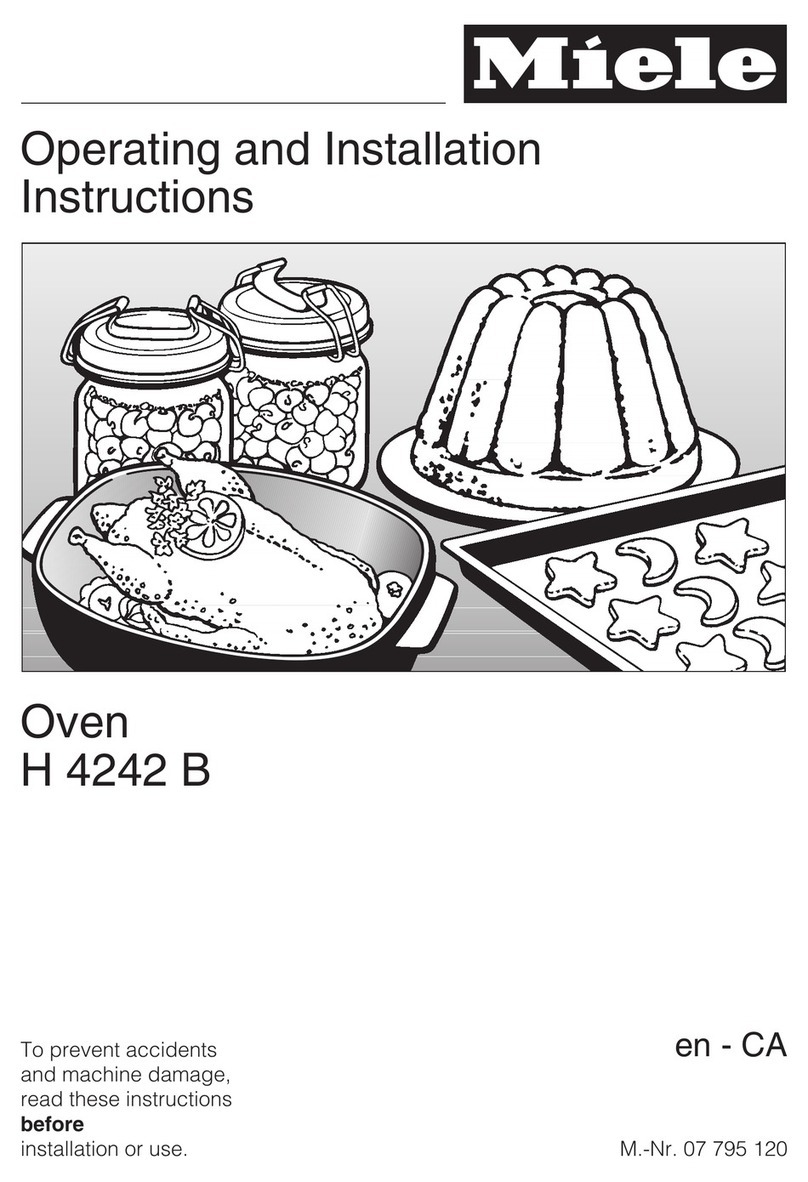
Miele
Miele H 4242 B Operating and installation instructions
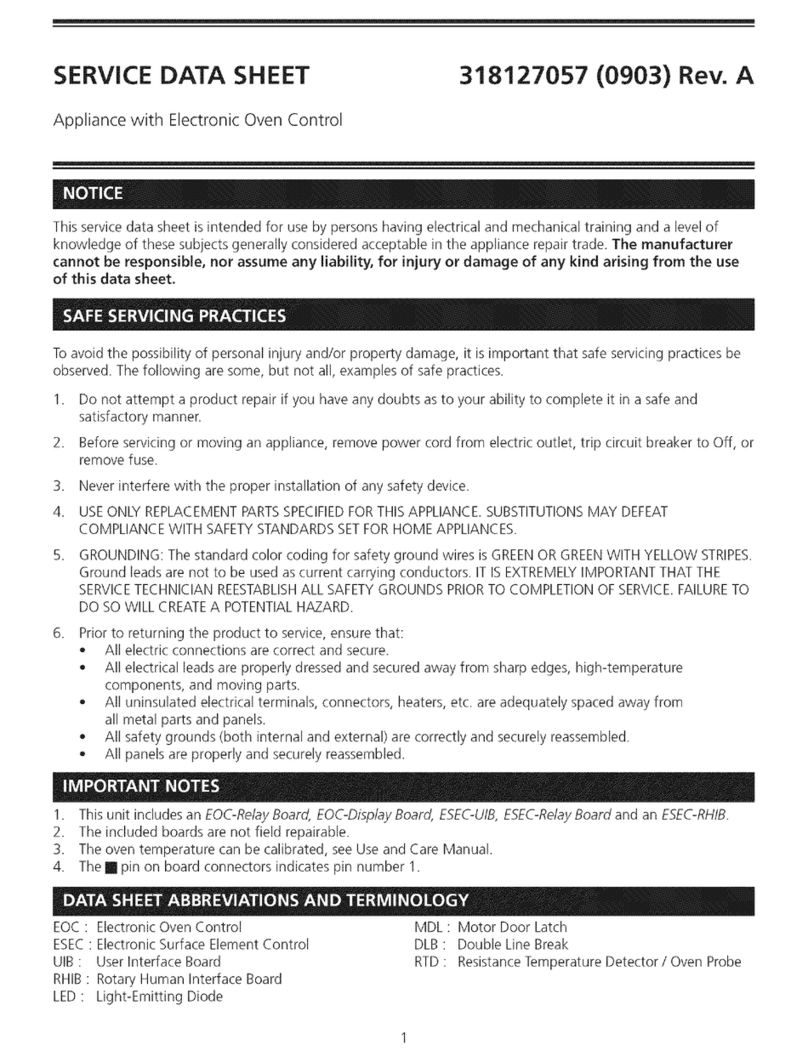
Frigidaire
Frigidaire CGES3065KF1 Service Service data sheet

Ariston
Ariston FR 34 S GB Instructions for installation and use

Saturn
Saturn ST-EC 1072 manual
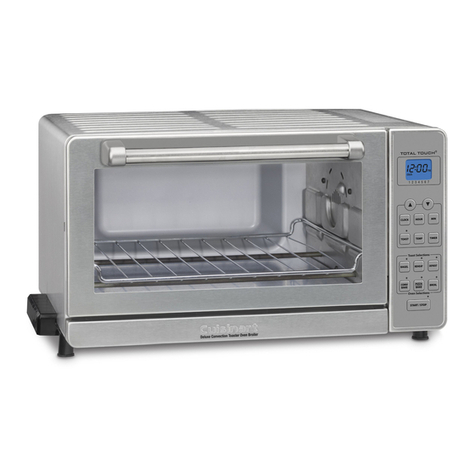
Cuisinart
Cuisinart TOB-130 INSTRUCTION AND RECIPE BOOKLET



